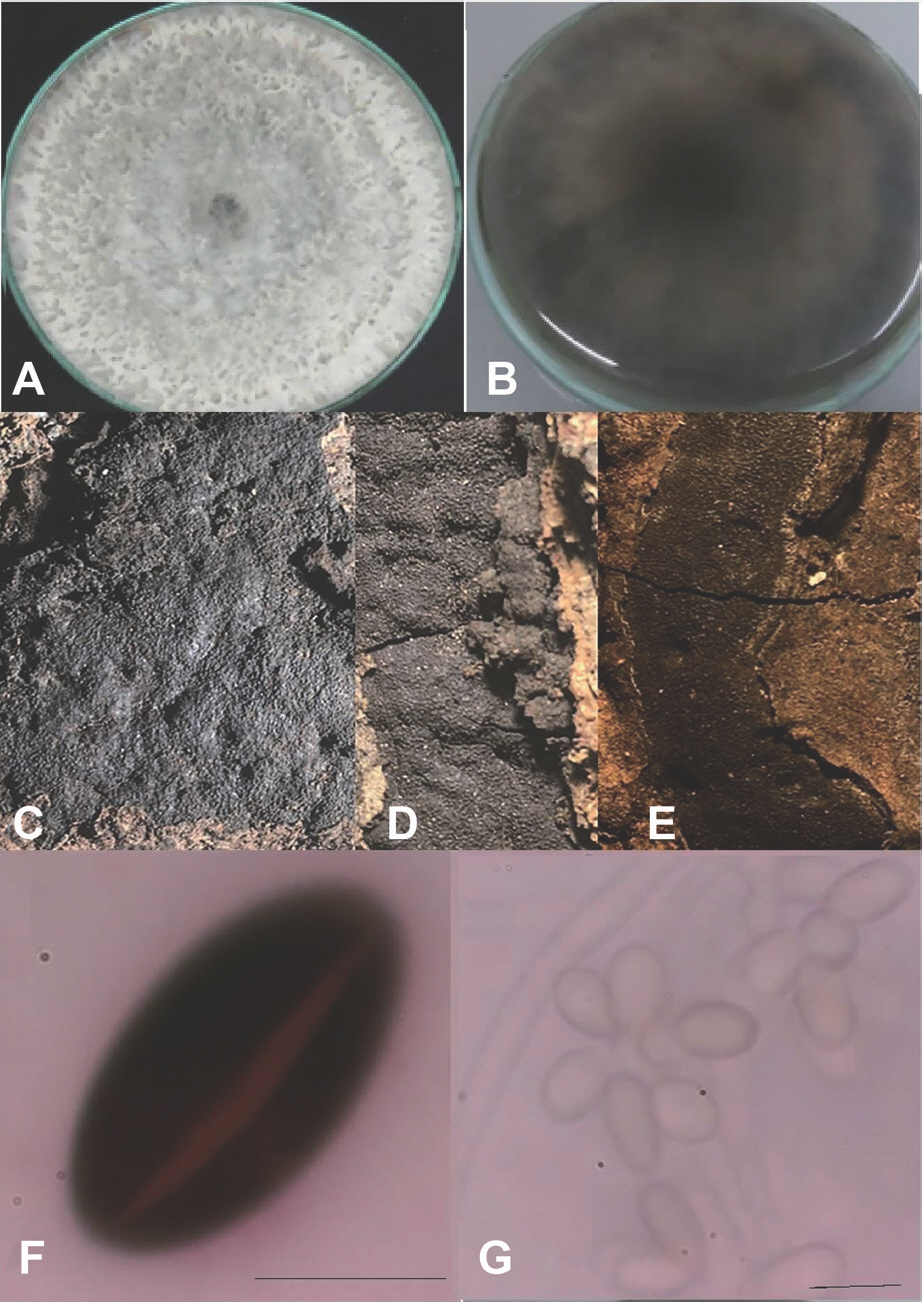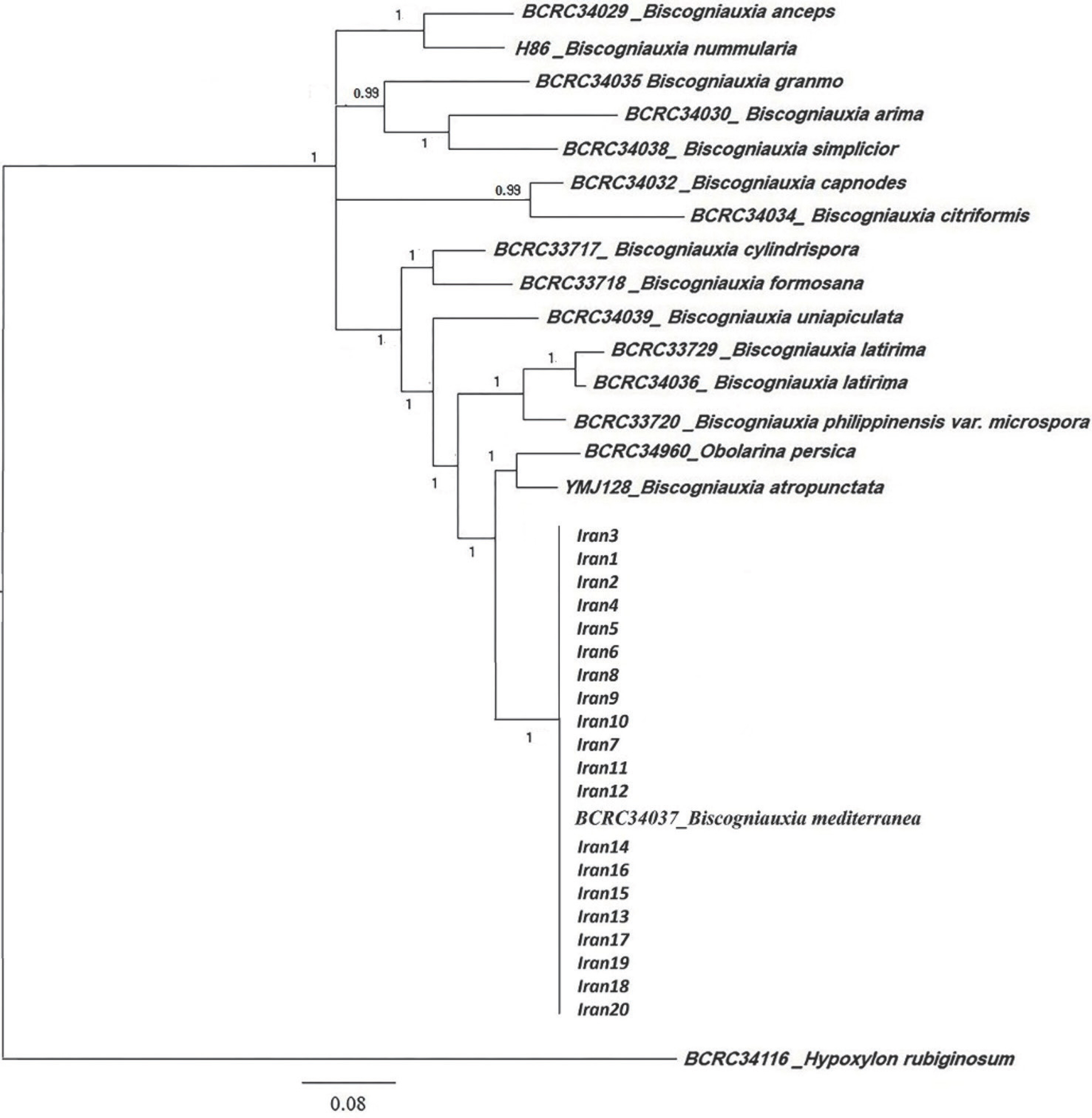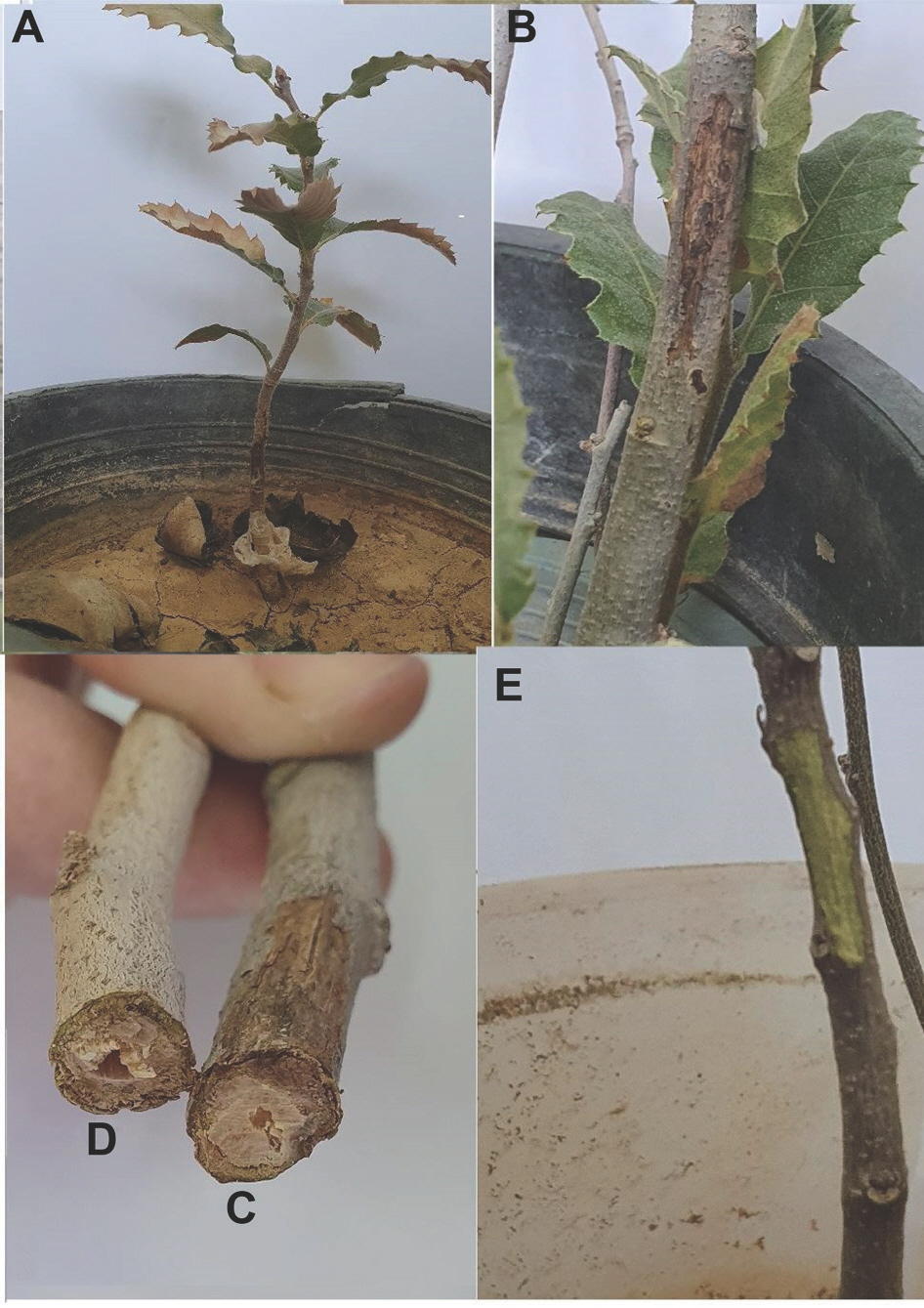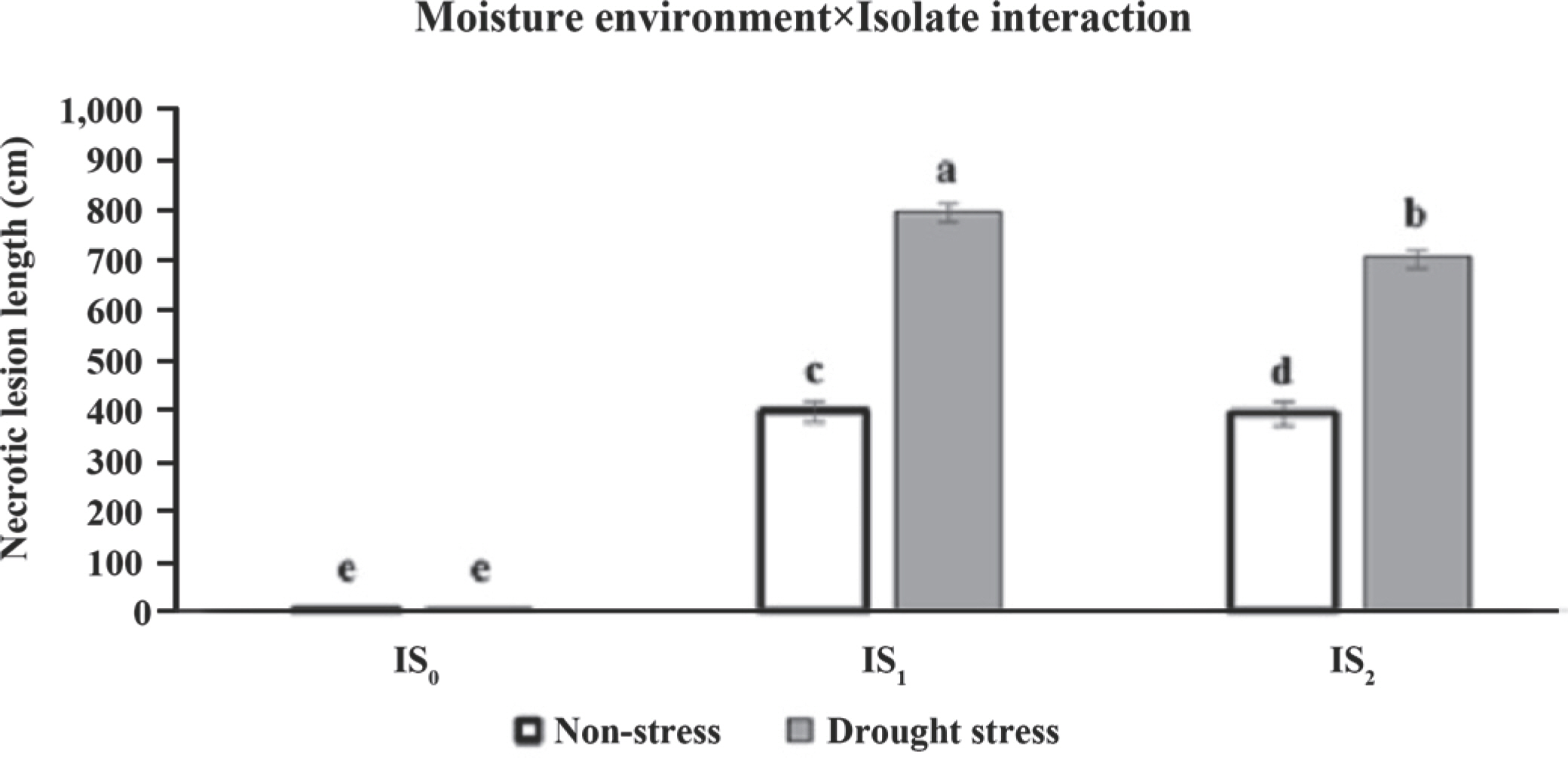Aranda, I., Castro, L., Pardos, M., Gil, L. and Pardos, J. A. 2005. Effects of the interaction between drought and shade on water relations, gas exchange and morphological traits in cork oak (
Quercus suber L.) seedlings.
For. Ecol. Manag. 210: 117-129.

Capretti, P. and Battisti, A. 2007. Water stress and insect defoliation promote the colonization of
Quercus cerris by the fungus
Biscogniauxia mediterranea.
For. Pathol. 37: 129-135.

Carbone, I. and Kohn, L. M. 1999. A method for designing primer sets for speciation studies in filamentous ascomycetes.
Mycologia 91: 553-556.

Carter, M. R. and Gregorich, E. G. 2007. Soil Sampling and Methods of Analysis. CRC Press, Boca Raton, FL, USA. 1264 pp.
Collado, J., Platas, G. and Peláez, F. 2001. Identification of an endophytic
Nodulisporium sp. from
Quercus ilex in central Spain as the anamorph of
Biscogniauxia mediterranea by rDNA sequence analysis and effect of different ecological factors on distribution of the fungus.
Mycologia 93: 875-886.

Corcobado, T., Cubera, E., Juárez, E., Moreno, G. and Solla, A. 2014. Drought events determine performance of
Quercus ilex seedlings and increase their susceptibility to Phytophthora cinnamomi.
Agric. For. Meteorol. 192-193: 1-8.

Cotrozzi, L., Remorini, D., Pellegrini, E., Landi, M., Massai, R., Nali, C. et al. 2016. Variations in physiological and biochemical traits of oak seedlings grown under drought and ozone stress.
Physiol. Plant. 157: 69-84.


Emadodin, I., Reinsch, T. and Taube, F. 2019. Drought and desertification in Iran.
Hydrology 6: 66.

Faraji, S., Hadadinejad, M., Abdossi, V., Basaki, T. and Karami, S. 2020. Screening pomegranate (
Punica granatum L.) genotypes for drought tolerance using physiological and phytochemical characteristics.
Fruits 75: 130-140.

Franceschini, A. and Luciano, P. 2009. Main pests and diseases of cork oak forests in Sardinia. In: Cork Oak Woodlands and Cork Industry: Present, Past and Future, ed. by S. Zapata, pp. 172-195. Museu del Suro de Palafrugell Publisher, Girona, Spain.
Ghaderi, F. and Habibi, A. 2021. Morphological and molecular char-acterization of
Phytophthora species associated with root and crown rot of pomegranate in Iran.
Plant Pathol. 70: 615-629.


Ghanbary, E., Tabari Kouchaksaraei, M., Mirabolfathy, M., Modarres Sanavi, S. A. M. and Rahaie, M. 2017. Growth and physiological responses of
Quercus brantii seedlings inoculated with
Biscogniauxia mediterranea and
Obolarina persica under drought stress.
For. Pathol. 47: e12353.


Giambra, S., Torta, L., Scopel, C., Causin, R. and Burruano, S. 2009. Primi studi su
Biscogniauxia mediterranea in Sicilia Occidentale. In: Atti del Terzo Congresso Nazionale di Selvicoltura, pp. 1394-1396. Accademia Italiana di Scienze Forestali, Firenze, Italy

Goharrizi, K. J., Baghizadeh, A., Kalantar, M. and Fatehi, F. 2020. Combined effects of salinity and drought on physiological and biochemical characteristics of pistachio rootstocks.
Sci. Hortic. 261: 108970.

Henriques, J., Barrento, M. J., Bonifácio, L., Gomes, A. A., Lima, A. and Sousa, E. 2014. Factors affecting the dispersion of Biscogniauxia mediterranea in Portuguese cork oak stands. Silva Lusit. 22: 83-97.
Henriques, J., Inácio, M. L., Lima, A. and Sousa, E. 2012. New outbreaks of charcoal canker on young cork oak trees in Portugal. IOBC/WPRS Bull. 76: 85-88.
Hsieh, H.-M., Ju, Y.-M., Hsueh, P.-R., Lin, H.-Y., Hu, F.-R. and Chen, W.-L. 2009. Fungal keratitis caused by a new filamentous hyphomy-cete Sagenomella keratitidis. Bot. Stud. 50: 331-335.
Hsieh, H.-M., Ju, Y.-M. and Rogers, J. D. 2005. Molecular phylogeny of
Hypoxylon and closely related genera.
Mycologia 97: 844-865.


Ju, Y.-M. and Rogers, J. D. 2001. New and interesting
Biscogniauxia taxa, with a key to the world species.
Mycol. Res. 105: 1123-1133.

Ju, Y. M., Rogers, J. D., San Martın, F. and Granmo, A. 1998. The genus Biscogniauxia. Mycotaxon 66: 1-98.
Jurc, D. and Ogris, N. 2006. First reported outbreak of charcoal disease caused by
Biscogniauxia mediterranea on Turkey oak in Slovenia.
Plant Pathol. 55: 299.

La Porta, N., Capretti, P., Thomsen, I. M., Kasanen, R., Hietala, A. M. and Von Weissenberg, K. 2008. Forest pathogens with higher damage potential due to climate change in Europe.
Can. J. Plant Pathol. 30: 177-195.

Linaldeddu, B. T., Scanu, B., Maddau, L. and Franceschini, A. 2014.
Diplodia corticola and
Phytophthora cinnamomi: the main pathogens involved in holm oak decline on Caprera Island (Italy).
For. Pathol. 44: 191-200.

Linaldeddu, B. T., Sirca, C., Spano, D. and Franceschini, A. 2011. Variation of endophytic cork oak-associated fungal communities in relation to plant health and water stress.
For. Pathol. 41: 193-201.

Mansouri Daneshvar, M. R., Ebrahimi, M. and Nejadsoleymani, H. 2019. An overview of climate change in Iran: facts and statistics. Environ. Syst. Res. 8: 7.
Massey, F. J. Jr. 1951. The Kolmogorov-Smirnov test for goodness of fit.
J. Am. Stat. Assoc. 46: 68-78.

Mirabolfathy, M., Groenewald, J. Z. and Crous, P. W. 2011. The occurrence of charcoal canker disease caused by Biscogniauxia mediterranea on chestnut-leaved oak (Quercus castaneifolia) in the Golestan forests of Iran. Plant Dis. 95: 876.
Mirabolfathy, M., Ju, Y.-M., Hsieh, H.-M. and Rogers, J. D. 2013.
Obolarina persica sp. nov., associated with dying
Quercus in Iran.
Mycoscience 54: 315-320.

Mollaei, Y. T. 2019. The root results of oak sudden death in Plain Barm, Zagros Forest, Fars, Iran. JOJ Wildl. Biodivers. 1: 555558.
Murray, M. G. and Thompson, W. F. 1980. Rapid isolation of high molecular weight plant DNA.
Nucleic Acids Res. 8: 4321-4325.



Nugent, L. K., Sihanonth, P., Thienhirun, S. and Whalley, A. J. S. 2005.
Biscogniauxia: a genus of latent invaders.
Mycologist 19: 40-43.

O'Donnell, K. and Cigelnik, E. 1997. Two divergent intragenomic rDNA ITS2 types within a monophyletic lineage of the fungus
Fusarium are nonorthologous.
Mol. Phylogenet. Evol. 7: 103-116.


Ragazzi, A., Mancini, F., Dellavalle, I., Captreti, P. and Moricca, S. 2001. Endophytic fungi in Quercus cerris: isolation frequency in relation to phenological phase, tree health and the organ affected. Phytopathol. Mediterr. 40: 165-171.
Ranjbarfordoei, A., Vandamme, P. and Samson, R. 2013. Some ecophysiological characteristics of artà (
Calligonum comosum Ľ Hérit) in response to drought stress.
For. Sci. Pract. 15: 114-120.


Rogers, J. D., Ju, Y.-M. and Candoussau, F. 1996.
Biscogniauxia anceps comb. nov. and
Vivantia guadalupensis gen. et sp. nov.
Mycol. Res. 100: 669-674.

Ronquist, F., Teslenko, M., van der Mark, P., Ayres, D. L., Darling, A., Höhna, S. et al. 2012. MrBayes 3.2: efficient Bayesian phylogenetic inference and model choice across a large model space.
Syst. Biol. 61: 539-542.



Sabeti, H. 1994. Forest, Trees, and Shrubs of Iran. 2nd ed. Yazd University, Yazd, Iran. 810 pp.
Saeidnia, F., Majidi, M. M., Mirlohi, A. and Ahmadi, B. 2018. Physi-ological responses of drought tolerance in orchardgrass (
Dactylis glomerata) in association with persistence and summer dormancy.
Crop Pasture Sci. 69: 515-526.

Safaee, D., Khodaparast, S. A., Mirabolfathy, M. and Mousanejad, S. 2015. Pathogenicity assessment of Obolarina persica on Persian oak tree and seedling. In: Proceeding of 2nd Iranian Mycological Congress, p. 120. University of Tehran, Tehran, Iran
Safaee, D., Khodaparast, S. A., Mirabolfathy, M. and Mousanejad, S. 2016. A multiplex PCR-based technique for identification of
Biscogniauxia mediterranea and
Obolarina persica causing charcoal disease of oak trees in Zagros forests.
For. Pathol. 47: e12330.


Safaee, D., Khodaparast, S. A., Mirabolfathy, M. and Sheikholeslami, M. 2017. Some aspects of biology and host range of Biscogniauxia mediterranea, one of the causal agent of oak charcoal disease. Mycol. Iran. 4: 121-129.
Swofford, D. L. 2002. PAUP*: phylogenetic analysis using parsimony (*and other methods). Sinauer Associates, Sunderland, MA, USA.
Vannini, A., Lucero, G., Anselmi, N. and Vettraino, A. M. 2009. Response of endophytic
Biscogniauxia mediterranea to variation in leaf water potential of
Quercus cerris.
For. Pathol. 39: 8-14.

Vasilyeva, L. N., Stephenson, S. L. and Miller, A. N. 2007. Pyrenomycetes of the Great Smoky Mountains National Park. IV. Biscogniauxia, Camaropella, Camarops, Camillea, Peridoxylon and Whalleya. Fungal Divers. 25: 219-231.
White, T. J., Bruns, T., Lee, S. and Taylor, J. 1990. Amplification and direct sequencing of fungal ribosomal RNA genes for phylogenetics. In: PCR Protocols: A Guide to Methods and Applications, eds. by M. A. Innis, D. H. Gelfand, J. J. Sninsky and T. J. White, pp. 315-322. Academic Press, New York, NY, USA.










 PDF Links
PDF Links PubReader
PubReader ePub Link
ePub Link Full text via DOI
Full text via DOI Download Citation
Download Citation Supplement1
Supplement1 Print
Print






